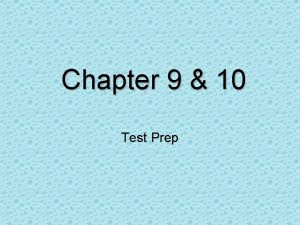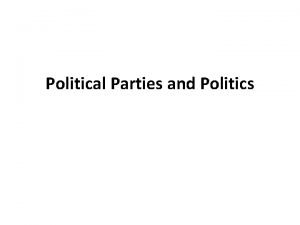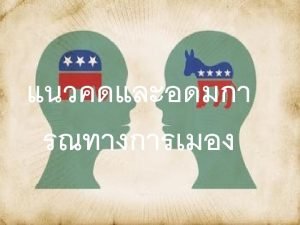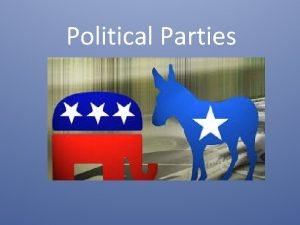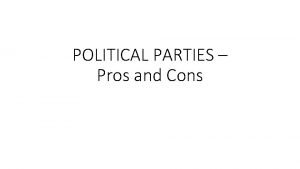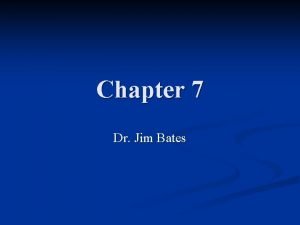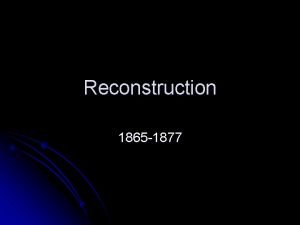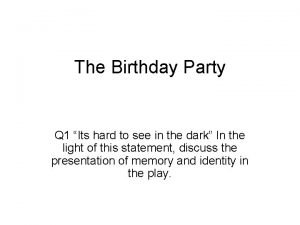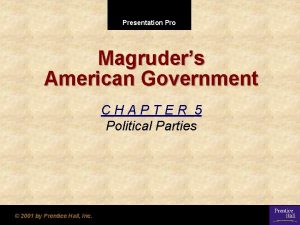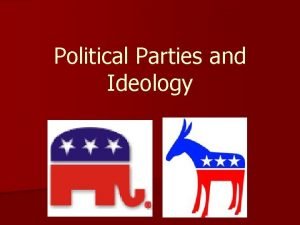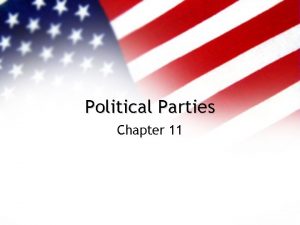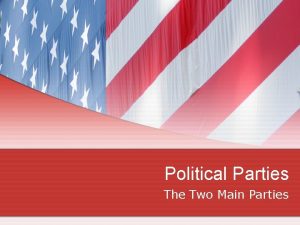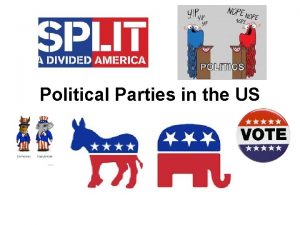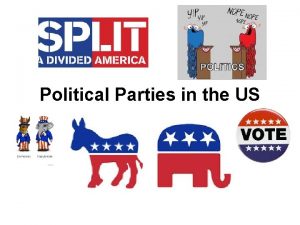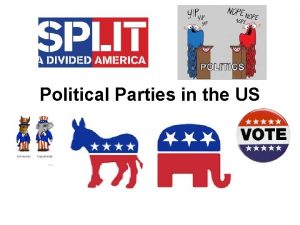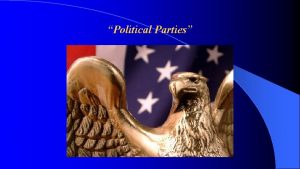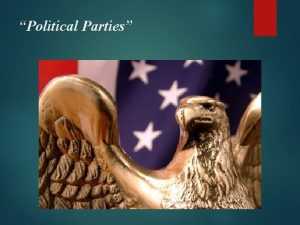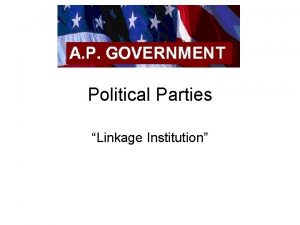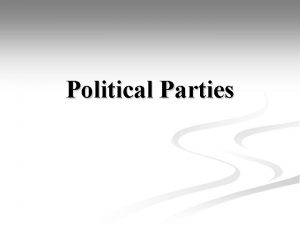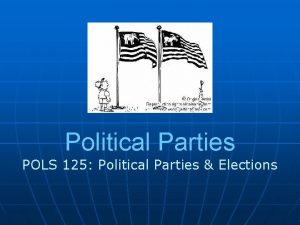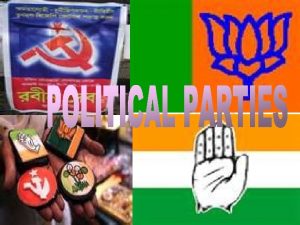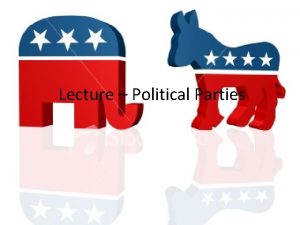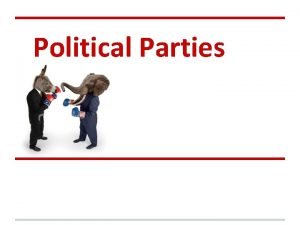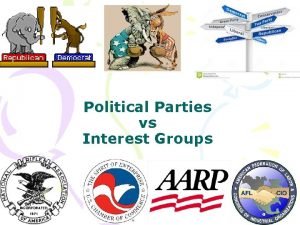Political Parties Lecture Vs Why Political Parties Provide


















- Slides: 18

Political Parties Lecture Vs.

Why Political Parties? -Provide a label (party identification) -Organization, recruiting, campaigning of politicians -Set of leaders to organize and try to control the legislative process and executive branch

Today in the United States- Parties are weaker in all three arenas -As a label, more independents than ever -As a set of leaders, still somewhat strong, but look at approval ratings -As an organization, parties have weakened since the 1960’s

US compared to European Parties -Europeans are disciplined gatekeepers, voters loyal -Our Federal system decentralizes power *Early on most power and important decisions were in state and local govts. , as well as most political jobs. *national parties were coalitions of local and state parties *as political power became more centralized, parties became more decentralized and weaker (regulation): 1. Parties closely regulated by state and federal laws 2. Candidates are now chosen through primaries, not by party leaders 3. President elected separately from Congress and presidential appointees are drawn from many sources

Political Culture Authors argument: -Parties are relatively unimportant in American life *Americans do not join or pay dues to a political party -Political parties are separate from other aspects of life. Do you agree?

THE RISE AND DECLINE OF THE POLITICAL PARTY. � THE FOUNDING �THE FOUNDERS DISLIKED PARTIES AND FACTIONS � JEFFERSON'S ORGANIZATION OF HIS FOLLOWERS WAS NOT SEEN AS ONLY AN ATTACK ON HAMILTON, BUT ON THE NATIONAL GOVT. � HAMILTON AND HIS GUYS ORGANIZE INTO THE FEDERALISTS (WHY CALLED FEDERALISTS? )

THERE WERE TWO EMERGENT GROUPS The first party, the Republicans (Democratic Republicans) � The Federalists (Hamilton's group) �

NATURE OF EARLY PARTIES The parties were actually caucuses, operating as nominating groups. �New England was strongly Federalist �The South was strongly Republican �The influence of the Republicans was so strong, the Federalists seemed to disappear

CONCLUSIONS TO BE DRAWN �First parties' weakness were that they were the first �no strong ancestral ties to the party � nobody considered themselves to be professional politicians. �Federalist party did not have wide appeal. �Early parties were heterogeneous coalitions- no homogeneous economic interests

THE JACKSONIANS: SECOND PARTY SYSTEM �largest voter eligibility in history �presidential politics brought to the people, not just the elites Party system under the Jacksonians was bottom up, rather than top down �By 1832, presidential electors selected by popular vote in most states �End of presidential caucuses, begin national conventions- allows for local control

SECTIONALISM: SPLITS IN THE PARTY 1860 -1930 � Slavery was the major issue � caused split in Whigs (anti Jackson) and Democrats

DEMOCRATIC REPUBLICANS DIVIDE INTO DEMOCRATS AND REPUBLICANS �Republicans only third party to achieve majors- Whigs fade away �Dominate politics for the next 75 years

CIVIL WAR AND ELECTION OF 1896 AID THE GOP �Union side became Republicans � supporters of the Confederacy become Democrats �Nominations of Williams Jennings Bryan alienates voters in the northeast �Most states dominated by one party

SPLITS WITHIN PARTIES: REPUBLICANS AND REFORM �Stalwarts: Old Guard Conservatives �Mugwumps (progressives) �giant reforms like direct primary, voter registration, referendum

The Era of Reform -Progressives pushed measures to curtail parties’ power and influence -non-partisan elections at city and some state elections -no party-business alliances, limit corruption -strict voter registration requirements to reduce fraud -civil service reform to eliminate patronage -initiative and referendum so that citizens could vote directly on proposed legislation

CONCLUSIONS �reduces corruption by weakening parties �makes way for special interest groups

Role of parties- remain the same �Label in the mind of voters �Organization for recruiting and campaigning for candidates. �Set of leaders who organize and control legislative and executive branches (national, state and local)

Party Realignments �Realignments occur when a sharp, LASTING shift occurs in the popular coalition supporting one or both parties. �Ex. Shift of African Americans to Democratic Party
 Hey bye bye
Hey bye bye Win the white house brainpop
Win the white house brainpop What was one way progressives differed from populists
What was one way progressives differed from populists Political parties
Political parties Political parties
Political parties Political
Political World political parties
World political parties Political parties
Political parties Political parties pros and cons
Political parties pros and cons 01:640:244 lecture notes - lecture 15: plat, idah, farad
01:640:244 lecture notes - lecture 15: plat, idah, farad Why does george wilson lock myrtle in the bedroom
Why does george wilson lock myrtle in the bedroom Why is gatsby's love for daisy doomed
Why is gatsby's love for daisy doomed Don't ask why why why
Don't ask why why why Why is this political cartoon called “one less vote?”
Why is this political cartoon called “one less vote?” Chapter 5 section 4
Chapter 5 section 4 Kids birthday program
Kids birthday program Chapter 5 section 1 parties and what they do
Chapter 5 section 1 parties and what they do Define ideological parties
Define ideological parties Foods party
Foods party


